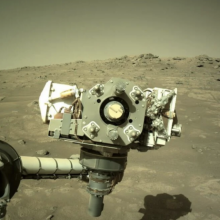The Perseverance rover has reached the top of the Jezero Crater rim on Mars, a hike that rose 1,640 feet — higher than the Empire State Building is tall.
NASA mission leaders said the rover, which had embarked on the journey 3.5 months ago, got its first look at its destination on Dec. 10. From there, the mobile lab will begin its fifth science campaign, pursuing a route dubbed "Northern Rim" that will span several years.
On the drive up, Perseverance encountered steep, slippery slopes. Its human operators, separated by some 70 million miles in space, had to brainstorm solutions on the fly to help navigate obstacles. At one point, the Jet Propulsion Laboratory team even tried steering the rover in reverse to see if that made the trek any easier.
"Our rover drivers have done an amazing job negotiating some of the toughest terrain we’ve encountered since landing," said Steven Lee, deputy project manager for Perseverance, in a statement.

The climb follows a highly productive summer for the rover and its twin Curiosity. They discovered several rocks that reveal Mars as having been a more geologically diverse planet than once thought. In a stretch of seven weeks, Perseverance and Curiosity found pure sulfur, a likely anorthosite boulder that could be a part of the planet's original crust, and a spotted rock with the most compelling signs of ancient Martian life yet, though a sample would need to be shipped back to Earth for confirmation.
Then this fall, as Perseverance rumbled up the crater, it found an odd zebra-striped rock that could have formed through igneous or metamorphic processes.
Jezero Crater is a site on the Red Planet where scientists believe a river once emptied into a body of water. The reason scientists now want to explore the rim is to look for ancient Martian bedrock rubble. Jezero formed when something substantial smacked into the planet close to 4 billion years ago. The impact could have churned up and tossed deep materials to the surface.
Over the first year of the new campaign, the rover is expected to visit up to four sites to collect samples, traversing about four miles. First stop: Witch Hazel Hill, composed of a vast layered field of rocks.
Tweet may have been deleted
"Each layer is like a page in the book of Martian history," said Candice Bedford, a rover scientist from Purdue University in Indiana, in a statement. "As we drive down the hill, we will be going back in time, investigating the ancient environments of Mars recorded in the crater rim."
Intriguing rock discoveries have only mounted pressure on NASA to solve the problems facing its proposed Mars Sample Return mission, an expensive and complex plan to fly bits of rock, dust, and air collected by Perseverance back to Earth.
The mission has been in limbo since a review found it would cost upward of $11 billion and take nearly two decades to achieve. NASA has since engaged the greater aerospace industry for input on how to save it. Earlier this year, seven companies suggested a variety of ideas, which Mashable reported, including repurposing Artemis moon landers and rethinking the last leg of the journey.
NASA hasn't yet announced its path forward, and it's unclear how the incoming administration will affect plans.
Topics NASA















